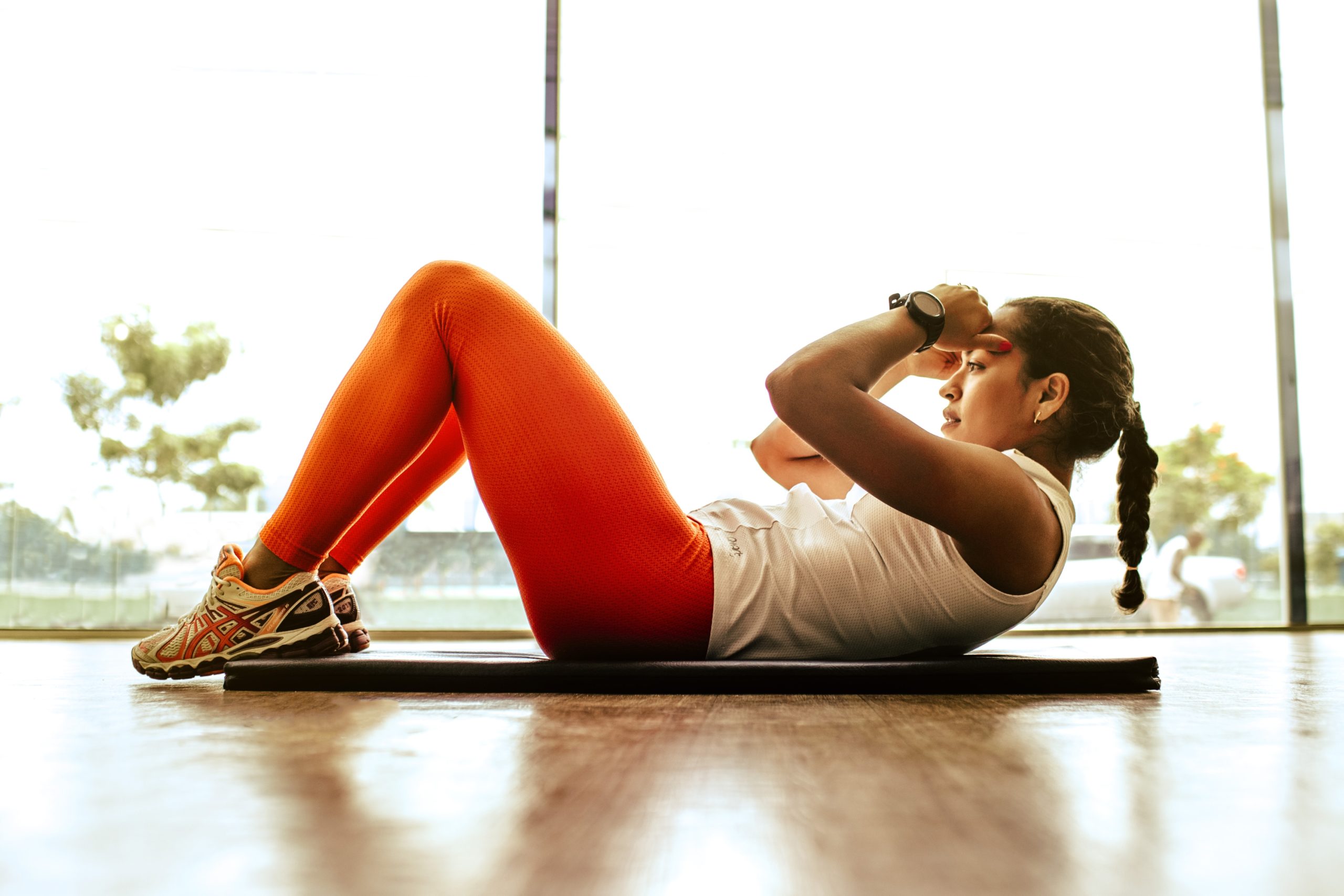Sit-ups are a classic exercise used to strengthen the abdominal muscles and achieve a toned midsection.
Whether you want to get in shape, build core strength, or feel healthier, sit-ups can be a great addition to your fitness routine.
But how many sit ups should you do a day to see the results? With so much conflicting information, it can be hard to know where to start.
In this article, we’ll dive into the science behind sit-ups and a guide to help you determine how many sit-ups you should do each day to reach your fitness goals.
Factors Influencing the Ideal Number:
1. Health Status:
- Do you have pre-existing back issues or other health concerns? Then you should consult with a healthcare professional or fitness expert before incorporating sit-ups into their routine.
2. Quality Over Quantity:
- Performing sit-ups with proper form is crucial to avoid strain and injury. It’s better to do fewer reps with correct form than to compromise form for quantity.
3. Fitness Level:
- Beginners should start with a lower number of sit-ups. Increase the number in a gradual manner as the core strength improves.
- Advanced individuals may need a higher volume to challenge their well-conditioned muscles.
4. Goals:
- For general fitness, a moderate number of sit-ups may suffice.
- If the goal is aesthetic (six-pack abs) do a combination of core exercises. Focusing on body fat reduction is essential.
Guidelines for Determining the Right Amount:
- Gradual Progression: Increase the number of sit-ups in a gradual manner. Allow your muscles time to adapt and recover.
- Consistency Matters: Consistent, regular practice is more effective than sporadic intense sessions. Aim for a balanced approach.
- Listen to Your Body: Pay attention to how your body responds to the exercise. Soreness is normal, but pain or discomfort may indicate an issue
- Rest and Recovery: Allow some time for your muscles to recover. Overtraining can lead to fatigue and potential injuries.
- Variety in Core Training: Incorporate a variety of core exercises to target different muscle groups. It can also reduce the risk of overuse injuries.

Health benefits of doing sit ups
1. Enhanced Breathing and Digestion:
A strong core supports the diaphragm, the muscle responsible for breathing. Improved breathing can have positive impact on lung capacity and oxygen intake. Additionally, a healthy core can aid in digestion by promoting proper organ function. It can also reduce the likelihood of gastrointestinal issues.
2. Mental Benefits:
Regular physical activity, including sit-ups, helps in improving mental well-being. Exercise releases endorphins, which can help reduce stress, anxiety, and symptoms of depression.
3. Versatility and Accessibility:
Sit-ups needs minimal equipment. We can perform it almost anywhere. This makes them a convenient and accessible exercise for individuals with diverse fitness levels.
4. Support for Lower Back:
Strengthen the core including the lower back muscles. It can provide extra support to the spine. This support is beneficial for individuals who may experience lower back pain or discomfort.
5. Increased Metabolism:
Sit-ups alone may not contribute to weight loss. But building muscle through exercises like sit-ups can increase metabolism. A higher metabolic rate can aid in weight management and fat loss. We should combine it with a balanced diet and regular cardiovascular exercise.
6. Athletic Performance:
For athletes in various sports, a strong core is crucial for optimal performance. Sit-ups can enhance the power and stability needed for some activities. They can be running, jumping, and rotational movements.
7. Core Strength:
Sit-ups primarily target the muscles of the abdomen. It includes the rectus abdominis, transverse abdominis, and obliques. Strengthening these muscles provides better core stability. It is essential for maintaining proper posture and supporting the spine.
8. Improved Posture:
A strong core contributes to better posture by helping to stabilize the spine and pelvis. This can reduce the likelihood of developing poor posture-related issues. Some examples are back pain and muscle imbalances.
9. Enhanced Flexibility:
Sit-ups engage the abdominal muscles through a range of motion. It promotes flexibility in the spine and surrounding muscles. Improved flexibility can contribute to better mobility and a reduced risk of injury.
10. Functional Fitness:
Core strength gained from sit-ups translates into improved performance in various daily activities. For example, lifting, bending, and twisting. This functional fitness aspect is crucial for maintaining an active and healthy lifestyle.
How to perform sit ups in a proper manner
Performing sit-ups with proper form is crucial to maximize the benefits of the exercise and reduce the risk of injury. Here’s a step-by-step guide on how to do sit-ups in a correct manner:
1. Starting Position:
- Lie on your back on a comfortable, flat surface such as a mat. Keep your knees bent, and place your feet flat on the floor about hip-width apart.
- Place your hands behind your head, with your elbows pointing out to the sides. You can also cross your arms over your chest.
2. Engaging the Core:
- Before lifting your upper body, engage your core muscles. You can do it by drawing your navel toward your spine. This helps protect your lower back and ensures that it works on your abdominal muscles.
3. Lifting Your Upper Body:
- Exhale and lift your upper body off the floor, leading with your chest towards your knees.
- Keep your neck in a neutral position. Avoid pulling on your neck or using your hands to yank your head forward. This can strain the neck and reduce the effectiveness of the exercise.
4. Full Range of Motion:
- Lift your upper body until your lower back is off the ground and your chest is as close to your knees as possible.
- Focus on using your abdominal muscles to perform the movement. Don’t rely on momentum.
5. Lowering Back Down:
- Inhale as you lower your upper body back to the starting position, in a slow manner and with control.
- Allow your shoulder blades to touch the ground between each repetition. Ensure that there is a full range of motion.
6. Feet and Hip Position:
- Keep your feet flat on the ground throughout the exercise. Your hip position should remain stable, and avoid lifting your hips off the ground.
7. Breathing:
- Exhale as you lift your upper body.
- Inhale as you lower your upper body back down.
8. Repetitions and Sets:
- Start with a manageable number of repetitions, such as 10-15. Increase in a gradual manner as your strength improves.
- Perform 2-3 sets, allowing adequate rest between sets.
Conclusion
There is no single answer to how many sit-ups one should do each day, as it depends on individual factors such as fitness level, endurance, and weight.
However, incorporating three sets of 15-20 reps into your workout routine is a good start. Sit-ups are a great way to strengthen muscles responsible for the spine and a toned midsection.
But remember, Sit-ups alone may not be enough to achieve your fitness goals, and it is crucial to include a variety of exercises that target different muscle groups and promote overall fitness and health.
Combining regular exercise with a balanced diet and healthy lifestyle habits can improve your physical and mental well-being and help you achieve your fitness goal.


Great insights! For those diving into AI Lead Generation, tyy.AI Tools is a must-visit hub with over 500+ vetted solutions to boost efficiency.
[url=https://cvetyvmoscve.ru/]Заказать цветы с доставкой в Москве[/url]
Заказать цветы с доставкой в Москве очень удобно и быстро. Множество компаний предлагают услуги доставки цветов в Москве, что дает возможность выбрать подходящий вариант.
Перед тем как оформить заказ, необходимо определиться с тем, какие цветы вы хотели бы видеть в букете. Рекомендуется рассмотреть как стандартные варианты, так и более креативные решения.
При заказе цветов стоит учитывать сроки доставки, а также другие предлагаемые услуги. Многие сервисы предоставляют возможность дополнить букет открыткой или другими мелкими подарками.
Очень важно доверять только проверенным компаниям с положительной репутацией. Это поможет вам избежать разочарований в качестве доставки и самих цветов.
hsjqvjlrmwglospqmjkqwkpttklovv
[…] After many years of experience as a seasoned body fitness trainer, We have come to realize that sit-ups top the list of exercises that barely require any […]
[…] Someone who is building strength after mastering wall push-ups […]
Outstanding post, you have pointed out some superb details , I as well conceive this s a very superb website.
What i don’t understood is actually how you are not actually much more well-liked than you may be now. You are so intelligent. You realize thus considerably relating to this subject, made me personally consider it from numerous varied angles. Its like men and women aren’t fascinated unless it’s one thing to do with Lady gaga! Your own stuffs excellent. Always maintain it up!